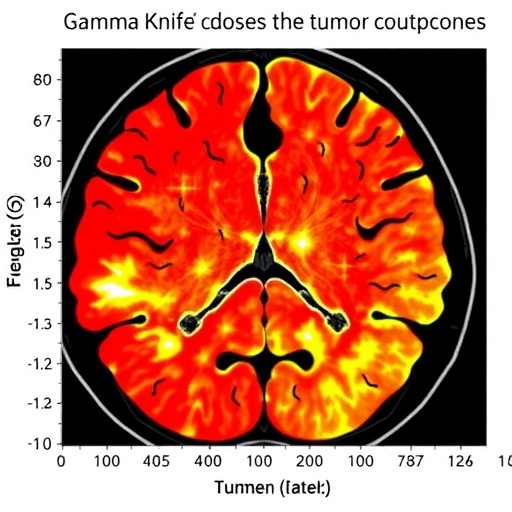Gamma Knife radiosurgery (GKS) has emerged as a pivotal therapeutic option for patients suffering from brain metastases, a condition notorious for its treatment challenges and poor prognoses. A recent study, published in the Journal of Cancer Research and Clinical Oncology, offers groundbreaking insights into how the dosing rate of gamma knife treatment and various tumor-specific characteristics influence patient outcomes. This cohort study, led by Erdoğan et al., examines critical variables that underscore the efficacy of gamma knife therapy in managing brain metastases, providing a comprehensive landscape of this innovative treatment modality.
The fundamental concept behind Gamma Knife technology is to deliver a precisely focused dose of high-dose radiation to targeted brain tumors while minimizing exposure to surrounding healthy tissues. The pivotal distinction in this study centers around the dose rate—a variable that can substantially affect tumor control and patient safety. Researchers conducted a detailed analysis revealing how different dose rates could lead to varied outcomes in terms of tumor response and side effects, bringing to light essential considerations for clinical decision-making.
Clinicians have long noted the complexities associated with treating brain metastases. The involvement of multiple tumor-specific factors complicates treatment protocols. Erdoğan and his team categorized various tumor types ranging from lung cancers to breast cancers, observing how the biological makeup of these malignancies can dictate the tumor’s response to GKS. Their study highlights the importance of personalizing treatment plans based on tumor-specific characteristics—a paradigm shift that paves the way for tailored oncology and improved patient outcomes.
One of the critical findings from the cohort study shows a direct correlation between the dose rate of radiation and the long-term control of brain metastases. Higher dose rates were associated with improved local tumor control, suggesting that optimizing the GKS can enhance its effectiveness in managing advanced disease stages. This discovery urges radiologists and oncologists to rethink current treatment protocols to embrace higher dose rates, which may lead to better patient prognoses.
Additionally, patient selection is paramount in the context of brain metastases. Erdoğan et al. identified specific patient characteristics that influence outcomes, including age, overall health status, and previous treatment histories. For instance, younger patients with fewer comorbidities tended to exhibit better responses to GKS when compared to older patients with multiple health issues. This aspect underscores the necessity for an interdisciplinary approach in oncology, where specialists can collaboratively assess a patient’s comprehensive health background alongside tumor specifics.
The study also delves into the potential side effects associated with different dose rates. While higher dose rates promise better tumor control, they are not without risks. The team emphasized the need for vigilance in monitoring patients for side effects such as radiation necrosis, which can impede quality of life. By addressing these concerns, the research advocates for a balanced approach in prescribing gamma knife treatments, whereby the benefits are carefully weighed against potential adverse effects.
Another noteworthy observation was the role of tumor morphology in treatment outcomes. Certain tumor types demonstrated a marked resistance to radiation despite higher dose rates. For instance, melanoma brain metastases were found to have a significantly different radiation response compared to adenocarcinoma. Erdogan and colleagues elucidated how understanding these nuances could help refine treatment strategies, potentially leading to the integration of adjuvant therapies alongside GKS to improve overall efficacy.
Moreover, the treatment outcomes were also influenced by tumor location within the brain. Tumors located in eloquent areas, such as those close to critical functional regions, posed significant challenges in achieving optimal control without compromising neurological function. The study highlights how innovative imaging techniques can assist in better targeting during GKS, thereby potentially improving the therapeutic index and mitigating the risks associated with radiation.
Patient-reported outcomes play a crucial role in assessing the effectiveness of gamma knife surgery, and this research takes that into consideration. Erdoğan et al. collected patient feedback regarding their experiences during treatment and the subsequent changes in their quality of life. The integration of these subjective measures into clinical studies emphasizes the importance of holistic patient care and can guide providers in tailoring post-treatment interventions.
As the field of oncology continues to evolve, the integration of artificial intelligence and machine learning presents exciting opportunities for enhancing gamma knife surgery’s effectiveness. The study hints at the potential of predictive analytics to develop models that could forecast treatment responses based on pre-treatment parameters. Such innovations could lead to more precise dosing strategies and contribute to the overall personalization of cancer care.
In conclusion, the insights forwarded by Erdoğan et al. present a compelling narrative on the multifactorial influences affecting gamma knife treatment outcomes in brain metastases. This cohort study elucidates the critical interplay between dose rates and tumor-specific characteristics, advocating for personalized treatment protocols. As the treatment landscape for brain metastases becomes increasingly sophisticated, these findings underscore the importance of continued research and dialogue within the medical community, ensuring that patients receive the most effective therapies tailored to their unique circumstances.
As we look to the future, ongoing investigations into optimizing gamma knife techniques and exploring patient-specific factors are essential in advancing our understanding of brain metastases treatment. This study represents a significant contribution to the growing body of research aiming to enhance individual patient care and improve long-term survival rates in those battling this challenging condition.
The concluding remarks center on the urgent need to implement the findings of this research into clinical practice. The call for standardized treatment protocols that incorporate the established dose rates and tumor-specific strategies suggests a promising shift in how we approach the management of brain metastases. The implications of this study echo through the halls of oncology departments worldwide, emphasizing the need for collaborative, evidence-based practices that could redefine patient care in this challenging area of medicine.
In light of such transformative findings, the scientific community stands poised to embrace the next generation of treatment paradigms for brain metastases, fostering a collaborative approach towards eradicating cancer.
Subject of Research: The effect of gamma knife dose rate and tumor-specific factors on treatment outcomes in brain metastases
Article Title: Effect of gamma knife dose rate and tumor-specific factors on treatment outcomes in brain metastases: insights from a cohort study
Article References:
Erdoğan, O., Fidan, A., Sakar, M. et al. Effect of gamma knife dose rate and tumor-specific factors on treatment outcomes in brain metastases: insights from a cohort study.
J Cancer Res Clin Oncol 151, 266 (2025). https://doi.org/10.1007/s00432-025-06322-7
Image Credits: AI Generated
DOI: 10.1007/s00432-025-06322-7
Keywords: gamma knife, radiosurgery, brain metastases, treatment outcomes, dose rate, tumor-specific factors, patient care, oncology.
Tags: brain metastases treatmentClinical decision-making in cancer treatmentcohort study on brain tumorsdose rate impact on outcomesefficacy of gamma knife therapyGamma Knife radiosurgeryhigh-dose radiation therapyinnovative cancer treatment modalitiesJournal of Cancer Research and Clinical Oncologypatient safety in radiosurgerytumor response variabilitytumor-specific factors in GKS





